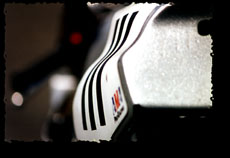|
|
|
||||
|
|
|
||||
|
Good examples of this are gearbox parts and top ends (cylinders, heads, pipes). We haven't bothered to detail minor changes such as a change in the material used in the screen ('95 model). Source of a lot of this info is Doug Mason, with various bits from a lot of different sources, and my own experience. |
|||||
|
1987 Last year of the "standard" layout parallel twin engine withcarburetors behind the engine and exhausts exiting from the front. Had Deltabox aluminum frame and braced aluminum swingarm.
1988 TZ250U First year of the "backwards" or "upside-down" parallel twin engine. Essentially the top pair of cylinders from a V-4. Cylinders were pointed about 45-degrees up. The pipes ran straight back from the cylinders out under the seat. Carburetors were under the cylinders, protected by a plastic sheet. Ducts from the leading edge of the lower fairing directed air to the carburetors. A very symmetrical bike with simple straight lines. The Deltabox aluminum frame still had full lower loops, making this series a favorite for housing other motors, particularly singles.
1989 TZ250W
1990 TZ250A Last year of the parallel twins. Significant power improvements were made. Vibration was a problem, with some motor mounts cracking. Change to 5.0" rear wheel.
1991 TZ250B First year of the V-twin motor. A completely new machine, sharing only a few parts with the earlier models. It was fairly closely related to the TZR250 road machine, as Yamaha gave the TZR high priority in order to celebrate Kocinski's championship with a road replica. This shortened the amount of time for development of the race model. Mid-range power was good, but top-end was inferior to the A-model. The new motor was a 90-degree V-twin, with cylinders pointed 45 degrees up and down from horizontal. The lower cylinder's carburetor was in the middle of the V, the top behind the cylinder. A counter-balancer was included. Some comments were made about problems with second gear. All motor parts from later models (at least through '95) are bolt on (cylinders, head, ignition, stator and pipes), with the need to modify the ports in the cases to match the cylinders. '91 had two transfers per side and two boost ports, later models had three transfers per side and one larger boost port. The frame was all-new to handle the narrower motor. The swing-arm was curved up on the right side to allow the lower exhaust pipe to tuck in close with adequate ground clearance. The lower carb was fed from two ducts on the leading edge of the lower fairing. The top carb was fed via a NACA duct on the right side of the fairing leading into a scoop feeding air into the airbox. 5.25" rear wheel.
1992 TZ250D Essentially a new bike from the B-model. A new frame, motor and fairing fulfilled the promise of the original V-twin. Individual airboxes fed by different ducting. One large boost port instead of the B's two, three transfers instead of two. The crank changed to smaller pins. The frame had dimples in the beams and the rear section was modified to position the shock several inches lower. The cross-member for the top of the shock was lowered, and the seat mounting frame was cleaned up. Shorter shock to go with the lower top mount and different linkage.
|
|
1993 TZ250 Change to Brembo cast-iron rotors. Some say that the '93 had exhaust ports that were too high, although I've got a great running '93 motor.
1994 TZ250 The ignition now offered different "maps" based on the rate of acceleration. This is valuable, as it would slightly increase the ignition timing during times of need, ie: off the corner. It was a change that was noticeable and very worth it. Thinner gas tank, redesigned bodywork, better cylinders and heads, different pipes. The rear wheel went to a 5.5" rear from 5.25" in previous years. The subframe is now detachable. Exhaust canisters were increased in length. Tail section mounting positions changed due to the new sub-frame. Harder 2nd and 4th gears for longer life.
1995 TZ250 Shortened carbs, different ignition with another acceleration map (5 total), different chambers, slight different exhaust port timing on the cylinders but otherwise unchanged from 1994. Exhaust canisters were again lengthened. Change in primary drive ratio, and first and sixth gears.
1996 TZ250 All new frame, and fairing with better ducting to airboxes. Contrary to frequent misconception, the 1996 TZ had "fresh air" ducts, which would run fresh air into the carb air boxes; these were not pressurized air boxes. The upper and lowers were changed to accommodate the air ducts and the new chassis mounting locations. Another ignition change (better mappings) and this was the last year for an ignition that supported leaded race gas. Different cylinders that had fill in places around the powervalves. There were many chassis changes including a different headstock with a slightly different rake/trail, the fork internals were changed slightly, the rear shock linkage is different, chambers were again changed. Marchesini magnesium wheels in 3.75" and 5.5" came standard, replacing the previous aluminum factory wheels. Rear axle OD increased from 20mm to 22mm. Opinion is mixed about the chassis changes. Some people thought that the redesigned chassis had more of a "dead" feel to it, but others thought it was the best frame of all. Yamaha changed the geometry back to the '92-'95 specification in 1997.
1997 TZ250 Motor changed to run unleaded, due to FIM regulations. Most people (particularly Rich Oliver) changed to '96 engine specs. Modifications are basically the heads and ignition system. Chassis geometry changed to match pre-'96 specification.
1998 Change back to stainless rotors.
The first three digits are for model identification. 3AK = 1988 3LC = 1989 3TC = 1990 3YL = 1991 4DP = 1992 |

